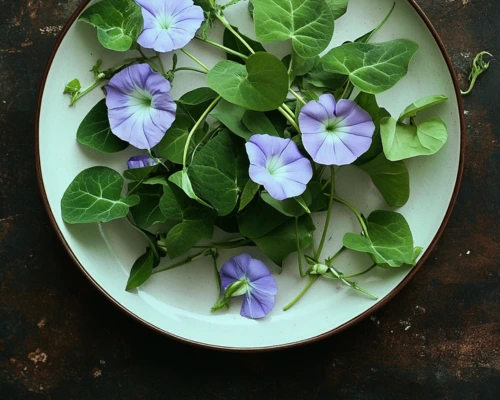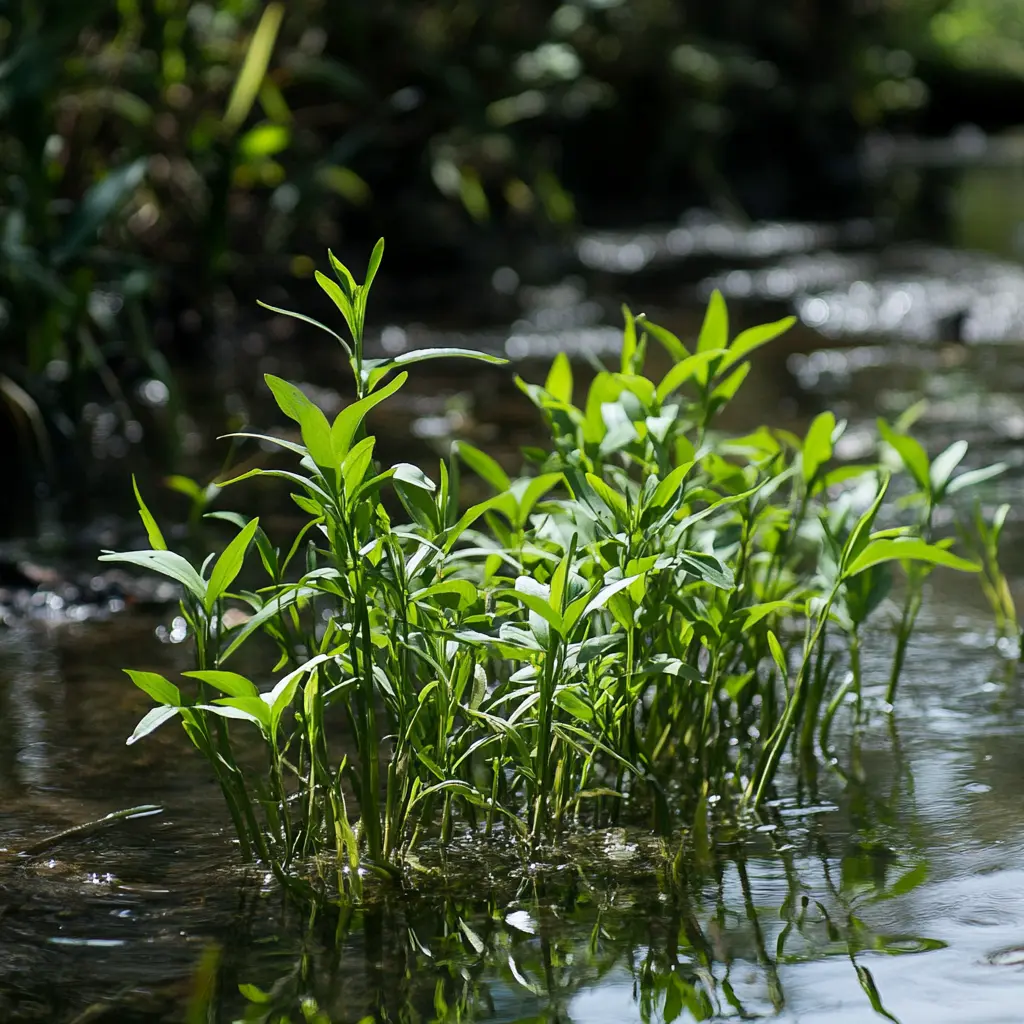Introduction for Water Spinach and Morning Glory
Are water spinach and morning glory the same? Food enthusiasts and gardeners often debate this question. While these two leafy greens share several similarities, they are distinct plants with unique characteristics. Both play a major role in cooking, especially in Southeast Asia, where they are staple ingredients in various traditional dishes. In this article, we will explore their definitions, key differences, and similarities, along with their nutritional benefits and culinary uses.
Table of Contents
What is Water Spinach?
Water spinach, scientifically known as Ipomoea aquatica, grows rapidly in tropical and subtropical regions. People commonly cultivate it in waterlogged soils, marshes, and along riverbanks, which makes it well-suited for wetland environments. The plant features long, slender stems, vibrant green leaves, and a mild, slightly sweet flavor. Its rapid growth and adaptability to various conditions make it a popular choice for both culinary and agricultural purposes in many parts of the world.
- Water spinach thrives in warm, moist conditions.
- People know it for its rapid growth and adaptability to various growing conditions.
- People typically harvest the plant for its tender shoots and leaves.
Water spinach is a key ingredient in many Asian dishes, particularly in stir-fries, soups, and salads. Its versatility in the kitchen and nutritious properties make it a popular choice among home cooks and professional chefs alike.
What is Morning Glory?
People refer to morning glory, or Ipomoea tricolor, as a flowering vine species in the same genus as water spinach. They often use the term “morning glory” to describe various plants. Many of these plants are grown for their striking, trumpet-shaped flowers. While some varieties of morning glory have culinary uses, especially in Asian cuisine, gardeners primarily value the plant for its aesthetic appeal. Its vibrant blooms and climbing growth make it a popular choice for gardens. However, people use its edible varieties less frequently in cooking.
This revision reduces sentence length while preserving the original meaning and structure.
- People typically grow morning glory plants for their vibrant flowers, making them a popular choice for ornamental gardens.
- Unlike water spinach, which thrives in waterlogged areas, people usually cultivate morning glory vines in well-drained soil. This distinction in growing conditions reflects their different environmental needs.
- In cooking, people use the leaves and stems of certain morning glory species, such as Ipomoea aquatica, in a similar way to water spinach. They incorporate these edible varieties into various dishes, particularly in Southeast Asian cuisine.
In the culinary context, people often confuse water spinach and morning glory. However, not all morning glory species are edible. The variety commonly used in cooking is typically grown for its tender leaves and stems, which people use in a variety of savory dishes.
Key Similarities Between Water Spinach and Morning Glory
Although water spinach and morning glory are distinct plants, they share several key characteristics that make them similar in appearance and usage. One of the most common questions people ask is, Are they the same? While they are not technically the same, they are closely related.
- Both belong to the Ipomoea genus of the Convolvulaceae family.
- Both have long, tender leaves and stems, which are edible.
- They thrive in warm, tropical climates, where they are commonly cultivated.
- Both plants are highly versatile in cooking and can be used in similar types of dishes, including stir-fries, soups, and salads.
In many parts of Southeast Asia, people use water spinach and morning glory interchangeably, which often leads to the belief that they are the same plant. This confusion arises partly from their culinary similarities, as both are commonly used in similar dishes like stir-fries and soups. Additionally, their shared habitat in tropical regions contributes to the mix-up, as both plants thrive in warm, moist environments.
Major Differences Between Water Spinach and Morning Glory
While the both have many common features, they also differ in significant ways. These differences become more apparent when considering the plants’ growth habits, culinary applications, and botanical classification.

- Botanical Classification: Water spinach belongs to Ipomoea aquatica, while morning glory, depending on the species, may refer to Ipomoea tricolor or other related plants.
- Growth Environment: Water spinach grows in waterlogged conditions, whereas morning glory is typically found in drier, well-drained soils and is more often cultivated for ornamental purposes.
- Edibility: While both plants are edible, the specific varieties of morning glory used for culinary purposes are limited to certain species, most notably Ipomoea aquatica. Other types of morning glory, particularly ornamental varieties, can be toxic if consumed.
- Culinary Uses: Both plants are used in similar ways in Southeast Asian cuisine. However, morning glory is more frequently featured as an ornamental plant in gardens, while water spinach is almost exclusively used for its edible parts.
Understanding these distinctions can help clarify the confusion and allow consumers to better appreciate each plant’s unique attributes.
Nutritional Benefits of Water Spinach
Water spinach is not only delicious but also offers a range of nutritional benefits that make it an excellent addition to any diet. Packed with vitamins, minerals, and antioxidants, it provides a variety of health-promoting nutrients.
- High in vitamins: Water spinach is rich in Vitamin A and Vitamin C, both of which are essential for maintaining healthy skin, eyes, and immune function.
- Rich in iron: The plant is a good source of iron, making it particularly beneficial for individuals suffering from iron deficiency or anemia.
- Low in calories: With a low-calorie content, water spinach is an excellent choice for anyone looking to manage their weight or adopt a healthier lifestyle.
- Rich in fiber: The plant’s fiber content helps support digestive health and may reduce the risk of chronic conditions like heart disease and type 2 diabetes.
Incorporating water spinach into your meals can help promote overall health and well-being. Whether consumed fresh in salads or cooked in savory dishes, this leafy green can be a valuable addition to any nutritious diet.
Uses of Morning Glory
People often cultivate morning glory for ornamental purposes, but they also use it in cooking, especially in Asian cuisines. They prize the edible species, primarily Ipomoea aquatica, for its tender leaves and stems, which they commonly include in various dishes like stir-fries and soups. Its mild flavor and versatile texture make it a popular choice in many traditional recipes.
- Stir-fries and sautés: Morning glory is frequently used in stir-fries, where its mild flavor complements garlic, chilies, and other savory ingredients.
- Soups and stews: The plant’s tender leaves and stems are perfect for adding to soups and stews, offering texture and a slightly earthy taste.
- Salads: Some cultures also use morning glory raw in salads, often paired with a tangy dressing.
- Herbal remedies: In some traditional medicine systems, the plant is believed to have various health benefits, including improving digestion and reducing inflammation.
Though morning glory may not be as widely consumed as water spinach, it is still an important ingredient in many regional dishes and has various uses beyond the kitchen.
Regional Importance about Water Spinach and Morning Glory
The question, Are the same?, is particularly relevant in regions where these plants are staples in daily life. (Ipomoea aquatica) and (Ipomoea tricolor) are crucial to many agricultural economies, particularly in Southeast Asia. These plants thrive in tropical climates, contributing significantly to local diets, cultures, and economies.
- In countries like Vietnam, Thailand, and Indonesia, both are often grown in flooded fields, making use of wetland areas.
- The plants are not just food sources; they are also important in traditional medicines and local rituals.
- In many regions, water spinach is a key ingredient in popular dishes like stir-fries and soups, while morning glory is frequently used in similar ways.
Therefore, understanding whether water spinach and morning glory are the same helps clarify their role in the cultural fabric of these areas.
Culinary Applications of Water Spinach
When considering whether they are the same, you must examine how each plant is used in cooking. Both plants offer similar culinary versatility, but they differ slightly in flavor and texture. People more commonly use water spinach for its edible shoots and tender leaves, while they use morning glory in a more selective range of dishes.
- Water spinach is often found in stir-fries, soups, and salads.
- The mild, slightly sweet flavor of water spinach pairs well with garlic, soy sauce, and chilies.
- Morning glory, with its somewhat more robust flavor, is also used in stir-fries and soups, particularly in Southeast Asian cuisines.
- It is commonly cooked with meat, shrimp, or tofu in various dishes.
Despite these uses, both plants adapt easily and people can enjoy them in a variety of ways in the kitchen.
Environmental Impact
An often overlooked aspect of both is their environmental impact. Since both plants grow in aquatic environments, they can play a significant role in ecosystem dynamics, but they also pose challenges when not properly managed.
- Water spinach, when introduced to non-native regions, can become invasive, spreading rapidly and overtaking local plant species.
- Both plants can absorb excess nutrients from water, potentially helping to reduce water pollution, but they can also exacerbate eutrophication if left unchecked.
- On the other hand, morning glory has a less pronounced environmental impact since it is primarily grown in drier soil. However, some species can still become invasive in certain regions.
Thus, understanding whether water spinach and morning glory are the same can inform decisions regarding their cultivation and environmental effects.
Growing Conditions for Each Plant
When asking are the same?, one of the primary differences lies in their growing conditions. While both plants are adaptable, they have specific requirements for optimal growth.

- Water spinach thrives in wet, waterlogged environments, often growing in fields with stagnant water or along riverbanks.
- It can be cultivated year-round in tropical climates and requires plenty of sunlight and high humidity.
- In contrast, morning glory prefers well-drained soil and is more tolerant of drier conditions, making it suitable for cultivation in raised beds or gardens.
- Morning glory also prefers full sun and is less reliant on water than water spinach.
These differences in growing conditions are critical for gardeners and farmers to consider when cultivating these plants.
Can Water Spinach Replace Morning Glory?
A common question that arises is whether water spinach can replace morning glory in certain culinary or gardening contexts. Although both plants share similarities, water spinach cannot fully replace morning glory in all uses due to differences in taste, texture, and appearance.
- While water spinach has a mild flavor that makes it a versatile ingredient in various dishes, morning glory’s slightly more bitter taste provides a distinct flavor profile in stir-fries and soups.
- Additionally, the growth habits of the plants differ. Water spinach, requiring wetter conditions, may not thrive in the same environments where morning glory does best.
- In culinary applications, you may substitute water spinach for morning glory in many recipes, but the result will be a slightly different taste and texture.
Explore pairing it with dishes like How Do You Cook Bob Evans Mashed Potatoes? for a hearty meal.
Therefore, water spinach can sometimes replace morning glory in cooking. However, this substitution is not always ideal. The overall flavor and texture profile can differ, making the replacement less effective in some dishes.
Common Misconceptions
There are several misconceptions surrounding water spinach and morning glory, largely due to their similarities and their widespread use in similar dishes. One of the most common misunderstandings is that the two plants are identical.
- Many people confuse the two because both are used in stir-fries and soups, leading to the assumption that they are the same plant.
- Another misconception is that all morning glory varieties are edible, but this is untrue. Some species, especially ornamental types, are toxic and should not be consumed.
- Similarly, some believe water spinach can be grown in dry soil, which is incorrect. Water spinach thrives only in waterlogged environments.
Clarifying these misconceptions is essential for both culinary purposes and sustainable agriculture.
Frequently Asked Questions (FAQs)
Are water spinach and morning glory the same?
No, while both belong to the Ipomoea genus, they are different species. People primarily grow water spinach (Ipomoea aquatica) for its edible leaves and stems, whereas they typically cultivate morning glory (Ipomoea tricolor) for ornamental purposes, although some varieties are edible.
Can I substitute water spinach for morning glory in cooking?
Yes, water spinach can be used as a substitute for morning glory in many dishes. However, the flavor and texture may differ slightly, so the dish may not taste exactly the same.
Is morning glory edible?
Only certain varieties of morning glory are edible. People most commonly use Ipomoea aquatica, known as water spinach, in cooking. Many ornamental varieties of morning glory are toxic and people should avoid consuming them.
Where does water spinach grow best?
Water spinach thrives in waterlogged conditions and people typically grow it in wetland areas, such as riverbanks or flooded fields. It requires high humidity and plenty of sunlight to grow successfully.
Is water spinach invasive?
Yes, in some regions, water spinach can become invasive, spreading rapidly and choking out local vegetation if not managed properly.
Conclusion
So, are water spinach and morning glory the same? While they share some similarities, particularly in their botanical family, they are distinct plants with unique characteristics. Water spinach is a key ingredient in many Southeast Asian dishes and requires specific growing conditions, thriving in wet environments. Morning glory, though edible in certain varieties, is more commonly grown for ornamental purposes and prefers drier soil.
Both plants offer significant environmental benefits but must be managed carefully to prevent issues like invasiveness. Understanding their differences in culinary applications and growing conditions will help you make informed decisions whether you’re gardening or cooking. While water spinach can sometimes replace morning glory in the kitchen, it cannot fully replicate the unique flavor and texture that morning glory provides.

